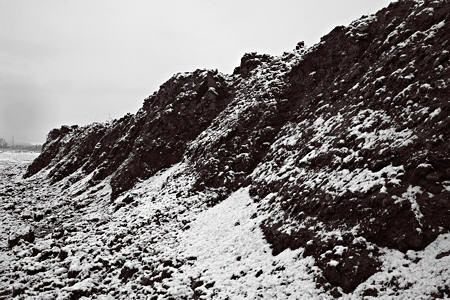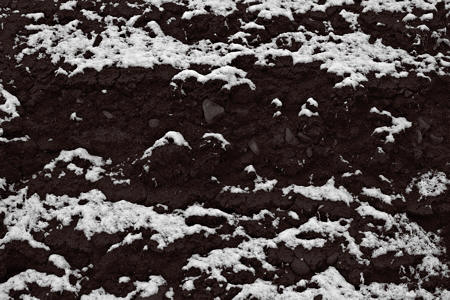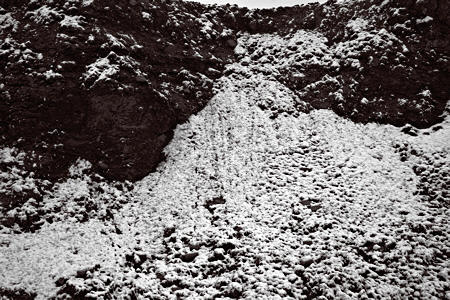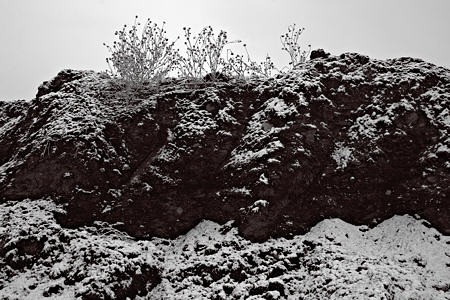
We have some impressive mountain ranges in Montana, but this isn’t one of them. Though reminiscent of the Bridgers that stretch north of Bozeman, this is, in fact, a dirt pile. I came across it while cruising through a future subdivision, killing time before an appointment and in a mood to photograph. As a handy subject for the 20-30 minutes I had, it was about perfect.

I don’t like to have such a limited time to make pictures, though it can be enough for just taking pictures. The difference is mindset: making pictures, to me, entails greater awareness, immersion, and attachment. Taking pictures is faster and more detached. I really don’t know whether one or the other leads to better images; that’s an interesting topic for, perhaps, a future post. The answer is probably different for each photographer. But in terms of the feeling of the process, I enjoy making more than taking.

These pictures bear a family resemblance to my views of Pine Creek Falls. But this set is much more about black and light, much less about shades of gray. Can we even utter that phrase without bringing to mind morality and ethics? But let’s be serious; that was not my intention. These pictures are not a statement about good and evil.

Or are they? Certainly that connection did not occur to me when I was photographing, nor when I was processing the raw images. I was concerned about the balance between dark and light, about the relative values and the boundaries and the coexistence and the interpenetrations and, at times, the larger setting. But isn’t it possible that the way I consider such things “aesthetically” has something to do with how I consider them “morally?” Do some ways of thinking cross our conventional modes?
Perhaps this is just on my mind because I read this morning a story in the New York Times entitled “Finding Hope in Knowing the Universal Capacity for Evil.” It’s all about the malleability of the human mind.

And now, I may be stuck with the association of these images with the thoughts just expressed, like that ditty Debbie Cornfield taught me I can’t help but remember when I hear the theme of Schubert’s Unfinished Symphony. It will affect how I process and present the images next time (assuming there is one). Will the images be any better? Will they even be noticeably different? I don’t know! And at this point, aren’t you glad I didn’t show you the other 36?

Steve,
This seems all pretty muddled to me. Are you imitating my style?
The first photo is very Steve Durbinesque. I like it a lot. The others are less characteristic of you, don’t you think?
The difference is mindset: making pictures, to me, entails greater awareness, immersion, and attachment. Taking pictures is faster and more detached.
Steve, this is a key to me the absolute key insight. This is what busted my New Year’s resolution to photograph every day. I could force myself to take pictures every day, but not to make pictures every day. In fact, the process of making pictures is such a strong mindset and commitment that when not doing it and doing something like painting instead, I feel an intense need not to get into “making pictures” mode. It is almost like feeling I would have to give up my painter’s identity if I went to the other. That’s not to say I don’t like making photographs. I love it.
Yes, totally mud-dled! My shoes were a mess, but the snow was melting and I didn’t have time to get proper boots.
I think the first photo is more like earlier landscapes (which I haven’t shown you much of), while the others are more like other abstracts I’ve done, where the emphasis is on shapes on the flat surface, not depth. I’m slowly working out my way of merging landscape depiction with abstraction.
The images do not look flat to me.
Having looked at lot at the Sleeping Bear dunes, I can imagine the surrounding 3-D’s of your photos. For example, the run-off in your 4th picture looks like streaks of clay that wash down the dunes while the sand stays up.
I have an odd response to excavations in nature. On the MSU cornfield where I used to walk my dog, a large excavation took place to lay a very large pipe from the street to one of the buildings beyond the field. It struck me as a very unpleasant sight.
In Manhattan, Troels makes me peek through fences that protect excavations where houses are torn down and rebuilt. There, I don’t have that feeling.
I think my sense of being uncomfortable has more to do with seeing a ‘violation’ in nature.
Birgit,
I agree, the dirt pile is ugly. I also dislike what it represents: the development of formerly agricultural land. But I don’t have your or Weston’s sand dunes, so there are not so many subjects that naturally work well with a high contrast light vs. dark treatment. Once I get to the position of seeing in tonal patterns, the literal subject becomes less important.
Steve,
I am constantly impressed with your thoughtful open-mindedness. I wonder, though… about those quiet moments of self-reflection… do you feel, deep down inside, a momentum of… something… maybe… a conceptual edge?
Thank you, D., for a probing question…one I’d like to probe in turn, because it seems important. Are you sensing a lack, looking for such an edge and finding it not? Should the ambiguity of an image go only so far, and stop at something that says: “Here. This is it. This is me.”?
Should an artwork have that edge? By individualistic western thinking, I suppose yes. Does mine or do I? I don’t know. Perhaps that means no… I never think of it as self-reflection, just reflection. Did I get your question?
I’m reading Steve Edwards (still!) and he says “photographic art [in contrast to documentary art] typically abjures associations and interpretations. For art, vagueness or ambiguity are often the preferred modes.” And “the frame… is a rhetorical device that makes connections where none necessarily exist.”
And again, “What we see only takes place in the photograph.”
So, if I’m to overlay these ideas onto your work, Steve, you are abjuring interpretations, preferring ambiguity, but and nevertheless making connnections and showing us what is only in the photograph, which I would say necessarily leads us, however unwittingly, to meaning by which I would construe “concept”
How’s that for convolutions…..
As for edge, well, all photographs have edges, although not all are muddy.
I am constantly impressed with your thoughtful open-mindedness. I wonder, though… about those quiet moments of self-reflection… do you feel, deep down inside, a momentum of… something… maybe… a conceptual edge?
D.,
That is an interesting statement. I’m not quite sure what you are saying, but I like it. It has an ambiguity to it that makes me wonder, Steve, Are there any people in Montana aside from you, and if so, how or why do you consistently avoid taking pictures of them?
There are fewer people in Montana than in the city in Japan where I lived, even though the state is bigger than all of Japan. By the mathematics of probability, I hardly ever meet anyone!
I have been thinking about it before now, and I will likely be taking more people pictures in future. I think it’s a lot harder, and neither the process nor the result seem to fit especially well with the way I’ve found myself working for now. It’s a constraint I’ve chosen to work under to avoid spreading myself too thin. I’m still learning and changing so much in the limited areas I do work in. Don’t forget this is very much a spare time activity.
June,
What are you and Edwards smoking??!!? Art abjures associations and interpretations?!!?? Those would somehow reduce ambiguity??? To me it seems that the multiplicity of associations and interpretations that IS the ambiguity. Without them, there is no meaning and the photograph is just a dirty piece of paper.
Thanks June for something to bounce off of, especially this: “… vagueness or ambiguity are often the preferred modes…” of photographic art.
When I read this I heard the voice from Reefer Madness. Goofy Authority. Funny how that film made me want to…
I am suggesting that there is much to be gained by reacting against Edwards’ thinking. For me, visual (and conceptual) “vagueness” only creates unnecessary distance.
And Steve, with this work, I feel at a distance. You are there and I am here and when I look at what is there, I am still here. I (and hopefully, you) want me there. And once I am there, with you, where do we go? Etc.?
An example: I recently curated “A Sequence of 36” by Marc Horowitz. They are unframed.
http://dearts.net/MH.htm
D.,
Very nice sequence. And very nice question about distance. I’ll think about it over breakfast, but it may take longer…
Steve,
These pictures are not your usual ‘kind’… I am not too sure what I feel about these. Need to think about them some more… While you might allude to the fact that aesthetic and moral have a cause effect relationship, I would defer to say that our reactions to both aesthetic and moral values/choices are purely a result of environmental influences impinging on our impressionable minds throughout our lives…
D,
I liked the pictures that you have curated. They are unsettling and edgy… I am curious on what the intent of the artist might have been… Are there none and am I supposed to fend for myself…? Why are they untitled? Hope you do not mind me asking this…
Steve,
I find your studies of textures interesting, perhaps, because I spend so much time studying the texture of the sand on dunes.
Sunil,
I do not mind at all you asking but I would prefer to let you fend for yourself. If you have the time maybe you could look again and share with me your thoughts. Thanks.
D.,
Distance. While I appreciate the emotional closeness and impact of the photos in your sequence, I don’t think that is what I want for most of my projects. Even for the dead rabbit, there is some distance, some intellectuality to it. I could make the rabbit or even the dirt pile much more immediate or gripping or in-your-face, and I could imagine doing that for certain contexts (I see no need to limit myself to a single “definitive” presentation of a captured image). Perhaps I prefer a sense of contemplation to one of urgency, or I feel that I am leaving more room for the viewer to form an unpressured reaction. I haven’t thought in these terms before, but I expect I will more in the future. Thanks!
Sunil,
I’m definitely not asserting cause and effect between aesthetics and morality. As for environmental origin, I largely agree, though surely you’ve read some of the recent work on social cognition, mirror neurons, adaptiveness of altruism, etc.
What I am tentatively suggesting with those musings is that there might be over-arching ways of thinking (regardless of how they arise). For example, a sense of balance between or among opposing elements is applicable to both aesthetic and moral choices. I readily admit this is pretty vague, but maybe it would be interesting to go into in a post some other time.
Steve,
” Perhaps I prefer a sense of contemplation to one of urgency, or I feel that I am leaving more room for the viewer to form an unpressured reaction”
Interesting coment. Thought provoking. It helps my distant feeling from a lot of photography that I mentioned before in temrs of its slick, unpenetrable surface. We aren’t supposed to go “there” but stay “here” and yet still be affected by the image, just in our very individual, and maybe cerebral (as opposed to visceral) way.
As for these photos, in comparison to your other work, I feel vagueness as to what you are trying to explore. A sense of anonymonity(sp?) and coldness that a decimated landscape can give. The end of the world. That emptiness is perhaps similar to your other empty spaces. But those have life in them, or evidence of previous life, whereas these have almost none (not literally but on an emotional level). Coudl that be part of your exploration perhaps? Or who knows at this point..
Leslie,
You’re right, it’s not too well-defined what I’m doing here. It was a “what I did yesterday in photography when I had a free half-hour” sort of post. I did become interested with some possibilities. Your comment about these having less life feels accurate, which is ironic as they are immediate evidence of human effort to construct dwellings. That would certainly be part of what I was thinking when capturing the images. Whether that could be called the message, who knows at this point…
D,
Finally I got the time to look at the show you curated at http://dearts.net/MH.htm and here is what I have to say…
This is what it brings to my mind: These pictures depict life in a small town in middle America with its cast of somber brooding characters awaiting the next big thing
Personally I liked it a lot and it is reflective
Sense of light playing off the face in MH1 is super
The sculpture in a room with brick walls is great. Leads you to think what about the rest of the picture – is this being stolen or is this the preferred background
MH08 is crappy
MH09 is very evocative. It is almost like hearing the loss of someone close but not so dear
MH10 is surreal
MH16 is playful
MH22 is hopeful and intergenerational
MH26 is so open to stereotyping
MH36 is funny
That is what life is all about.